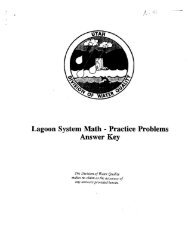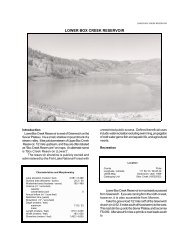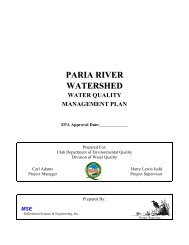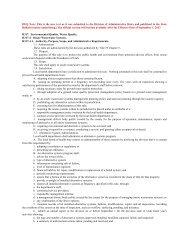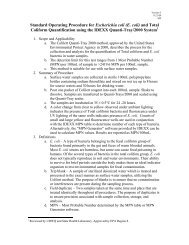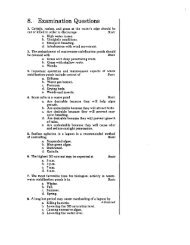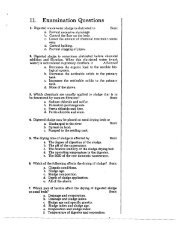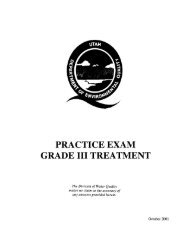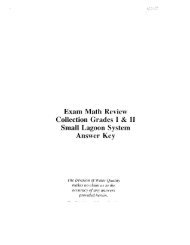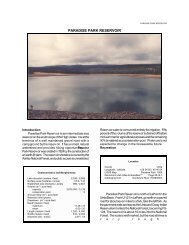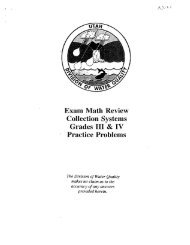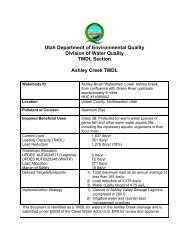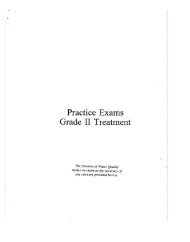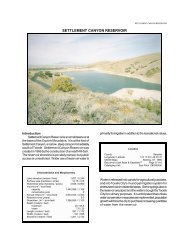What About the “R” in ASR?Betsy Woodhouse – <strong>Southwest</strong> <strong>Hydrology</strong>, University of ArizonaSouthern Nevada Water Authority ASR wellGetting water into the ground isfairly straightforward: water drainsdown from a basin or goes downa well. But then what happens to it? Willthe water really be there when it’s needed?Does it matter if the exact same water isthere to recover? Was water actually stored?The answers depend on the goals of theproject <strong>and</strong> the local regulatory framework.When fresh water is stored in saline orbrackish aquifers, common in the Southeast,mixing of the waters is undesirable: thegoal is to recover essentially the same waterthat was recharged. When fresh water isstored in fresh-water aquifers, as is typicalin the <strong>Southwest</strong>, recovering the same wateris less critical. The goal of such projectsmay be to reverse water level declinesin the aquifer or to store water long-termfor future drought or development.What <strong>Storage</strong> MeansFrom a physical st<strong>and</strong>point, water mustremain in a location that is definable <strong>and</strong>accessible for recovery in order to beconsidered “stored.” Rising water levelsin wells demonstrate that the volume ofwater stored in an aquifer is increasing.The Vidler Water Company has beenrecharging about 30,000 acre-feet peryear of Central Arizona Project waterSometimes recoveryof an equivalentmass matters morethan getting the samemolecules back.in its spreading basin facility in westernArizona since 2000; nearly a 200-foot risein water levels has been observed. TheSouthern Nevada Water Authority storeswater in a highly transmissive confinedaquifer that also is used by other entities. Itoperates on a seasonal cycle, storing waterduring the wet months when dem<strong>and</strong> islow (<strong>and</strong> natural recharge also replenishesthe aquifer) <strong>and</strong> pumping it during drymonths. Water levels fluctuate 35 to 40 feetbetween the two seasons, of which 13 to18 feet are attributed to artificial recharge.Permeability tests, tracer experiments(primarily using chloride), <strong>and</strong> flow<strong>and</strong> transport models have been used tostudy the behavior of recharged water inan aquifer. In general, recharged waterusually stays in a somewhat coherentmass in the subsurface for a period oftime after some initial mixing at theentry zone. How much <strong>and</strong> how quicklythe recharged water mixes with nativegroundwater depends on parameters suchas regional groundwater flow velocity<strong>and</strong> the dispersivity, transmissivity,<strong>and</strong> heterogeneities of the aquifer.If water is stored only briefly or theaquifer is not highly transmissive, therecharged water mass will likely maintainits integrity, permitting recovery of mostof the stored water. If the water is storedlonger, its mass may eventually dissipatethroughout the aquifer, but if the aquiferis well-constrained, storage will still beevident through elevated water levels.If the aquifer is very large or highlytransmissive, however, physical storagemay be measurable only briefly if at all.Another Kind of <strong>Storage</strong>From a regulatory perspective, storagecan simply mean credit for recharging acertain quantity of water which providesthe storing entity a right to withdraw waterin the future. The water need not stay inany particular location, although ideallyit should stay within the groundwaterbasin. In some states or regions, a storingentity receives an equal amount of creditsfor withdrawal as was recharged. Inother cases, a “tax” may be levied. TheArizona Water Banking Authority takesa five percent “cut to the aquifer” forrecharge of Central Arizona Project waterin recognition that some amount of wateris lost in the aquifer. However, that fivepercent does not have a scientific basis.Robert Maliva of SchlumbergerWater Services points out that so-26 • May/June 2008 • <strong>Southwest</strong> <strong>Hydrology</strong>
called “regulatory storage” can causeproblems. Where groundwater use of anaquifer is being limited because of localhydrogeologic concerns such as waterlevels in wetl<strong>and</strong>s or spring flows duringdry periods, the additional pumpingduring recovery from an ASR systemcould actually make matters worse. Ifthe aquifer is not sufficiently constrained<strong>and</strong> recharged, water spreads over a verylarge area <strong>and</strong> no long-term local rise inaquifer water level or pressure occurs tocompensate for subsequent withdrawals.Getting It BackWhen fresh water is recharged into brackishor saline aquifers, an initial “investment”of unrecoverable water is often necessaryto, in effect, clean out space in the aquifer.<strong>Recovery</strong> ceases when water qualitydeteriorates. When fresh water is rechargedinto a fresh-water aquifer, recovery of anequivalent mass matters more than gettingthe same molecules back—<strong>and</strong> storagemay only be of the regulatory kind.<strong>Recovery</strong> can take place on a regular cycle,such as during the annual dry season, or itmay simply be part of the long-term plan,such as for future development or droughtprotection. Many long-term projects in the<strong>Southwest</strong> have no specific recovery plansyet. In an ASR project under development,the City of Phoenix plans to recharge <strong>and</strong>recover on an annual cycle, but will onlyrecover slightly more than 50 percentof the 1,900 acre-feet per year that willbe recharged, with the remainder usedto maintain the aquifer for future needs.For the privately-owned Vidler <strong>Recharge</strong>Facility, recovery will be initiated at anundetermined time in the future dictated byeither sale of some or all of the water creditsor Vidler’s decision to build a developmentitself. Project goals also influenceplacement of the recovery system relativeto the recharge facilities (see sidebar).On <strong>Recovery</strong> Efficiency<strong>Recovery</strong> efficiency is strictly definedas the amount of useable water that isrecovered compared to the volume thatwas recharged, for a single recharge/recovery cycle in a dual-purpose well.This calculation is typically used whereIs Downgradient <strong>Recovery</strong> Better Than Upgradient <strong>Recovery</strong>?Mark Cross – Errol L. Montgomery & Associates Inc.Placement of recovery wells relative to recharge facilities varies widely in practice due to differencesin recharge <strong>and</strong> recovery objectives, legal <strong>and</strong> regulatory constraints, hydrogeologic conditions, <strong>and</strong>other factors. If the intent is to recover the same water that was used for recharge, recovery wellsshould be located at or down-hydraulic-gradient from the recharge site. However, if the objective ofrecharge is simply to increase the amount of water in storage, recovering the same water may notbe important <strong>and</strong> recovery wells need not be located at or downgradient from the recharge site.The physical benefits of recharge include increased water storage <strong>and</strong> water-level rise, or at leastreduced water-level decline. A common misconception is that these benefits are greater downgradientfrom a recharge site than upgradient. However, both theory <strong>and</strong> practice indicate that the benefits ofincreased storage radiate outward in all directions from a recharge site, depending only on aquiferhydraulic properties (transmissivity, storage coefficient). The magnitude of the water-level rise (or reducedwater-level decline) diminishes dramatically with distance from the recharge site. The magnitude ofwater-level rise does not depend on the rate or direction of groundwater movement, only on aquiferhydraulic properties <strong>and</strong> distance from the recharge site. Thus, if recovering the same water is notimportant, no advantage is gained by locating recovery wells downgradient from the recharge facility.Contact Mark Cross at mcross@elmontgomery.com.fresh water is stored in a brackish-wateraquifer for seasonal use; water is recovereduntil concentrations exceed a drinkingwater st<strong>and</strong>ard, such as for chloride ortotal dissolved solids. For fresh-watersystems having a well-defined aquifer, aquantity-based recovery efficiency can beestimated using a mass-balance approach<strong>and</strong> changes in water level elevations.According to Maliva, too much emphasisis placed on achieving high recoveryefficiency, with the implication that a projectis wasting water otherwise. But if water isbeing stored that would have been lost, thatin itself is a benefit. As an example, thetownship of Clayton, Australia, is storingfresh water in a saline aquifer. The recoveryefficiency of the project is less than 10percent, but the system is providing muchneededfresh water at lower cost than otheroptions <strong>and</strong> is viewed as a success. Thesystem stores excess lake water during wetperiods that would otherwise not be put tobeneficial use. The water that is recoveredcomprises a critical component of thetown’s water supply during dry periods.Water Is LostNo large-scale water storage system isloss-proof. Just as reservoirs lose someamount of water to evaporation, artificiallyrecharged water is undoubtedly not entirelyrecoverable, although one could argue thatat least it remains in its liquid form <strong>and</strong> goessomewhere. Loss to fresh-water aquifersgenerally is not monitored or calculated.It may not be a problem now when morerecharge than recovery is occurring, butwhen storing entities start cashing in theircredits, the importance of knowing wherethat water went will likely increase.Hydrogeologists NeededWater Management Consultants is aninternational company providing specializedservices in groundwater, surface water,geochemistry <strong>and</strong> engineering.The company is exp<strong>and</strong>ing rapidly <strong>and</strong> has aninteresting <strong>and</strong> challenging portfolio of projectsin the US. Excellent experience <strong>and</strong> careerdevelopment is offered to motivated individuals,together with competitive salary <strong>and</strong> benefits.Suitable c<strong>and</strong>idates are sought for the followingvacancies, based in our Tucson, Reno, <strong>and</strong>Denver Offices:Senior HydrogeologistA minimum of 7 year experience with a MastersDegree in <strong>Hydrology</strong> or closely relateddiscipline. Skills in numerical groundwater flowmodeling would be a strong advantage.Staff <strong>and</strong> Project HydrogeologistsGraduate through 4 years experience, with aMasters Degree in <strong>Hydrology</strong> or closely relateddiscipline. Strong ability in numerical <strong>and</strong>analytical hydrogeology <strong>and</strong> a willingness toparticipate in field programs.For further information or to arrange aninterview please contact Piccola Dowling:Telephone: 520 319-0725Email: pdowling@watermc.com3845 N Business Center Drive, Suite 107Tucson, Arizona, 85705.May/June 2008 • <strong>Southwest</strong> <strong>Hydrology</strong> • 27



